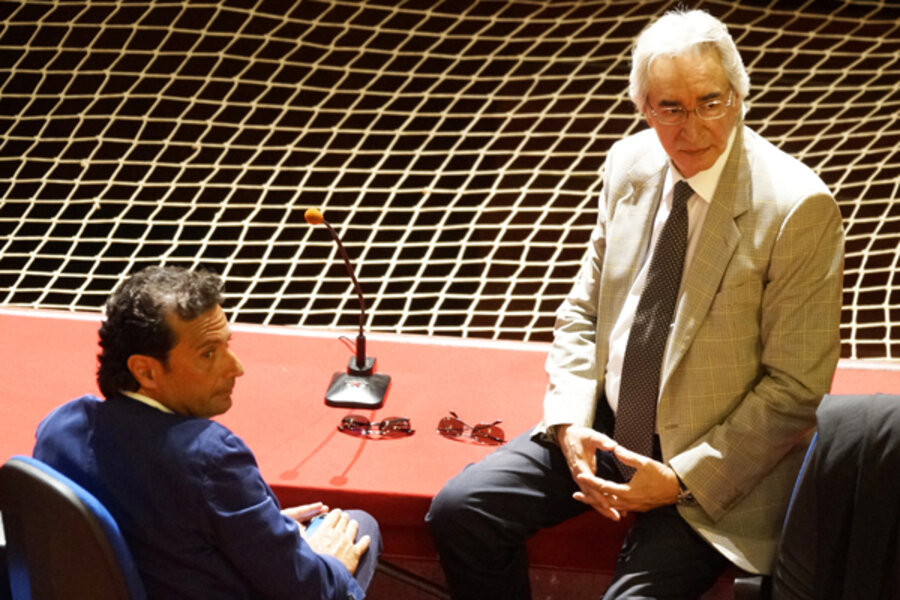Costa Concordia captain's trial begins in Italy
Loading...
| Grosseto, Italy
The trial of the captain of the shipwrecked Costa Concordia cruise liner began Tuesday in a theater converted into a courtroom in Tuscany to accommodate all the survivors and relatives of the 32 victims who want to see justice carried out in the 2012 tragedy, but the hearing was quickly postponed because of a nationwide strike by lawyers.
The sole defendant, Francesco Schettino, is charged with multiple manslaughter, abandoning ship and causing the shipwreck near the island of Giglio. He slipped through a back door and did not speak to reporters as he arrived at the courtroom.
Judge Giovanni Puliatti adjourned the hearing until July 17 because of a strike by lawyers over a long-running dispute with the Justice Ministry over proposed reforms.
Schettino's lawyer, Domenico Pepe, said that some 1,000 witnesses will be called to testify.
Many of the witnesses will be drawn from the 4,200 passengers and crew aboard the ship that struck a jagged reef off Giglio, took on water and capsized.
Schettino, depicting himself as a scapegoat, has denied wrongdoing.
One of the lawyers representing victims, Daniele Bocciolini, said what his clients wanted was simple. "We are asking for justice," he told Sky TG24 TV, indicating frustration that only the captain was put on trial.
Schettino is the only defendant," but he is not the only one responsible," Bocciolini said. "There is still a need to shed light on what happened."
Five other defendants successfully sought plea bargains, and their hearing will be held in Grosseto on July 20. Their sentences are expected to be far milder than the 20 years in prison Schettino might face if convicted.
The Concordia itself lies on its side and half-submerged off the tiny Tuscan island of Giglio, blighting the seascape for another summer in an otherwise pristine part of the Mediterranean.
Some 18 months after the hulking ship ran aground, it is a daily reminder of how slow the progress in dealing with the aftermath has been. The remains of two of the 32 dead have yet to be found. The timetable to salvage it has stretched on.
Although court-appointed experts concluded that the crew and owner Costa Crociere SpA, a unit of Miami-based Carnival Corp., committed blunders and safety breaches that contributed to the disaster off the island's rocky coast, only Schettino was ordered to stand trial.
Prosecutors contend that on the night of Jan. 13, 2012, Schettino steered the ship too close to the island's coastline in a publicity stunt for Costa Crociere and accidentally rammed the jagged reef. The cruise company denies that scenario.
Survivors described a chaotic and delayed evacuation, with crew allegedly downplaying the seriousness of the collision, which caused a gash 70 meters (230-feet) long in the Concordia's side and let seawater rush into the ship.
Schettino has protested his innocence. He insists that his skillful steering of the liner to just outside the port saved thousands of lives. He also contends the ship's navigational charts didn't indicate the reef was in its path as it cruised near the island on part of a weeklong Mediterranean tour.
A recording of a phone conversation between Schettino and an exasperated Italian coast guard official who repeatedly ordered the captain in vain to scramble back aboard the ship to direct the evacuation was played again and again in broadcasts around the world.
In interviews, Schettino insisted he is no coward. He claimed he had to leave the capsizing boat before it was impossible to launch any more lifeboats and that in the darkness he didn't see a ladder he could have used to climb back aboard.
On Giglio, where residents depend on tourism and fishing for their livelihoods, the wreckage still mars the panorama from the island's port. Salvage experts had originally predicted the ship could be tipped upright in an ambitious operation so towing could begin in spring of this year. But that timetable has slipped away.
The removal project involves some 400 workers representing 18 nationalities, including engineers and divers. On Monday, crews were busy securing some of the caissons being attached to one side of the crippled ship, which, the planners hope, will help the wreckage stay afloat when eventually righted so it can be towed to the mainland.
Islanders are impatient for the removal of the eyesore.
"We want our island back as it was," Giglio's mayor, Sergio Ortelli, told The Associated Press as he looked at the blue cove where he used to swim. Now, towering cranes and platforms of the removal team loom over the shipwreck.
Ortelli said authorities told the islanders the operation will begin in September to bring the wrecked ship upright again.
The island is still awaiting compensation for damages caused by the shipwreck, he said. "Our image was internationally damaged, and tourism figures have dropped off noticeably," the mayor said.
Meanwhile, the remains of an Italian woman who was a passenger and of an Indian man who worked as a waiter have still not been recovered.
"The saddest thing is to pass by on the ferry and think that two bodies are still there, or will never be found," said tourist Patrizia Giovanelli, who was making her second visit to the island.







